Research: The State of L&D
in 2022
How training and development shape
employee experience and empower organizational growth

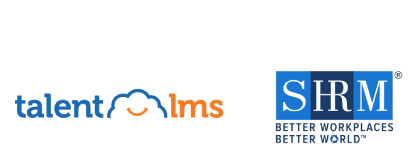
The pandemic has crept into its third year and the end is still not in sight.
Its toll on the workplace is high. The skills gap is deepening, quit rates are spiraling out of control, and stress and burnout are ravaging the workforce.
To respond to these challenges, leaders have turned to learning and development (L&D) teams, giving them a seat at the C-suite table for the first time. L&D has become one of the key catalysts in smoothing the shift from an in-person to a digital-first work setting.
And data from the new TalentLMS and SHRM research indicates that companies will invest even more in learning and development this year.
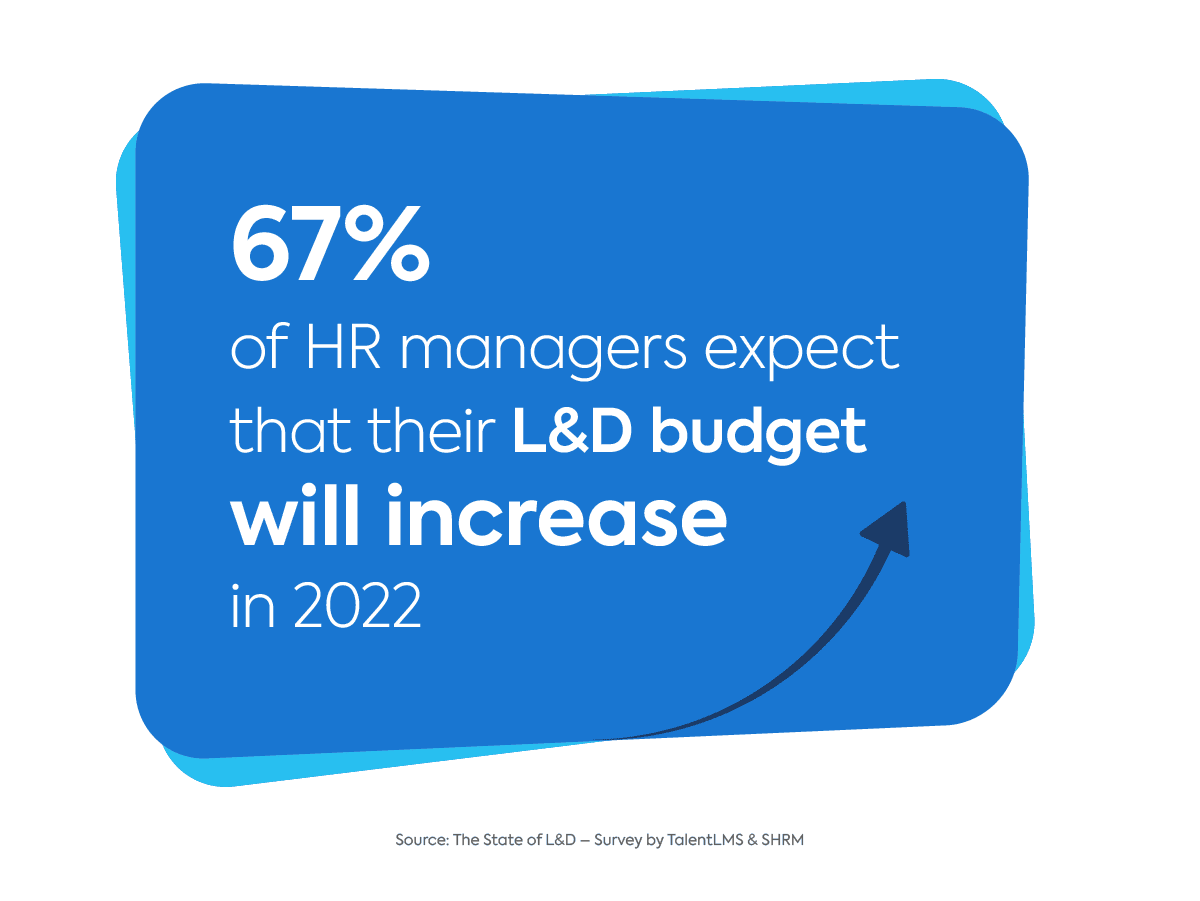
TalentLMS and the Society for Human Resources Management (SHRM) partnered to take the pulse of L&D in 2022 from two different perspectives: employees and employers. Two separate surveys examined:
L&D budget in 2022 and what are the roadblocks to further growth
How to improve the efficacy of workplace training and which are the key in-demand skills right now
What types of training and skills employees desire versus what employers offer
Why employees are seeking learning opportunities on their own
Key Findings
67% of HR managers agree that L&D budgets will increase in 2022
76% of employees agree that they are more likely to stay with a company that offers continuous training
Reinforcing positive employee experience is the leading L&D goal for over 9 in 10 organizations
72% of HR managers would invest in mental health and well-being training if they had a higher L&D budget
85% of HR leaders find training beneficial for organizational growth
More than 1 in 2 companies are facing a skills gap, and half of them are addressing it by training existing employees
Self-management will be among the top in-demand skills in 2022, with 83% of organizations focusing training initiatives on it
46% of companies have specific training in place for new grads who are just entering the workforce
Over half of HR leaders will provide their employees with upskilling (59%) and reskilling (55%) training in 2022
According to employees, companies can make training more effective by aligning training with job responsibilities, updating training content more frequently, and making training more social
Getting DE&I training is important to 25% of employees, while 40% of companies are providing it
L&D budgets have increased since the pandemic outbreak for 57% of organizations
L&D budget: How much is learning worth?
After a streak of growth in global spending on workplace learning between 2008 and 2019, the pandemic has put a hold on it. In 2020, U.S. companies had the first decline in spending on training.
But in many cases, companies didn’t go through L&D budget cuts. Instead, they made budget shifts.
The switch to remote work skyrocketed the adoption of online training tech. While training methods requiring a physical presence, such as in-person Instructor Led Training (ILT), have diminished with the digital shift, online employee training has flourished. As 2020 was wrapping up, LinkedIn revealed that 79% of L&D pros expect to spend more on online learning, while 73% foresaw spending less on ILT.
Before we dig into what this survey’s data showed about the impact of the pandemic on learning budgets, let’s first look into the current spending landscape.
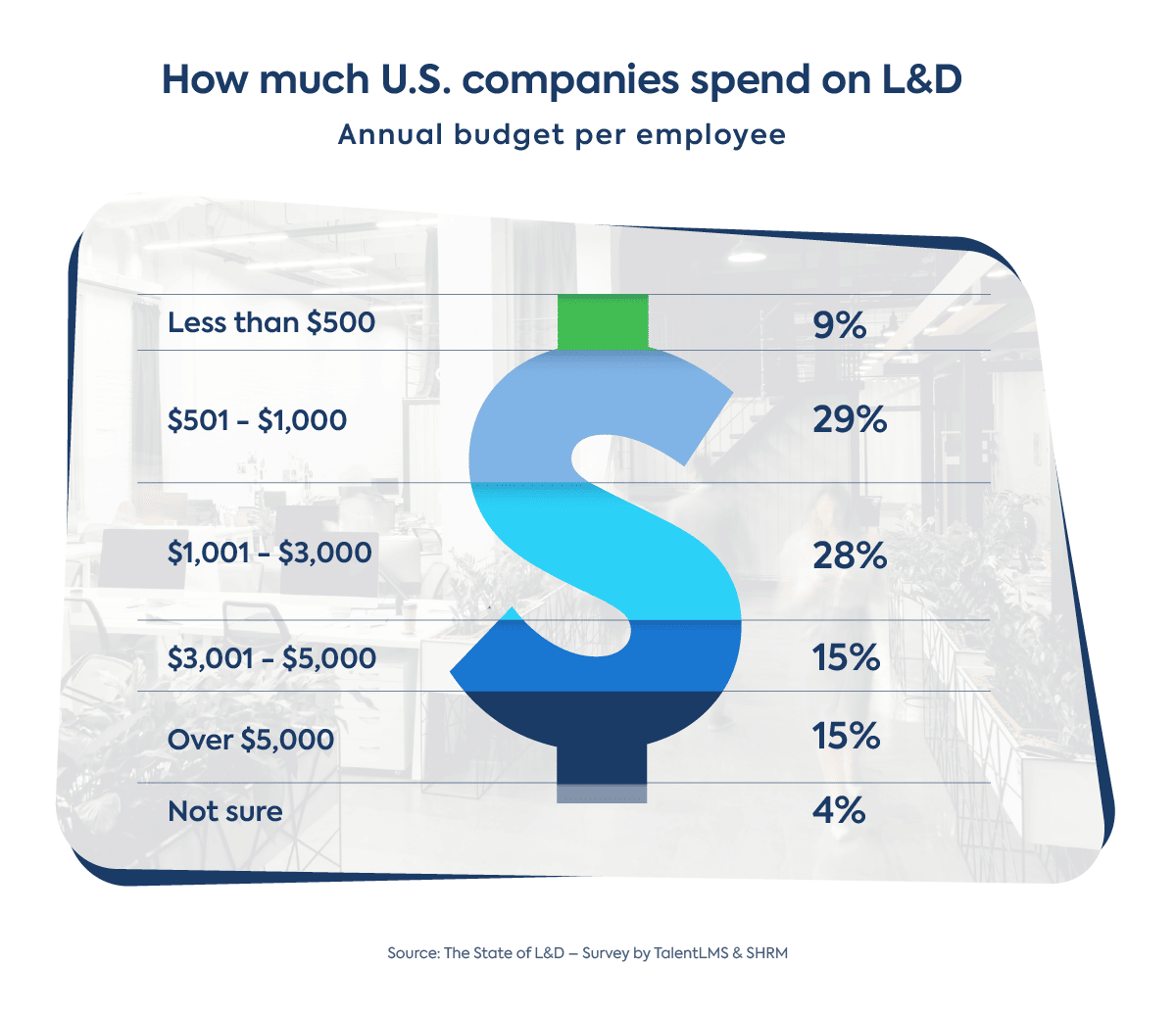
While the most frequent annual L&D budgets are $500 – $1,000 (29%) and $1,000 – $3,000 (28%), it’s interesting to see that 15% of companies are spending over $5k on training and development for each employee.
How has the pandemic affected L&D budgets?
We asked HR leaders to what extent they agree that their company has increased L&D budget since the pandemic started. And the majority (57%) agreed that their budget increased after the pandemic outbreak.
2022 L&D budget outlook and roadblocks to its growth
In 2020, over a third of global L&D experts said that a lack of budget is the biggest obstacle they have faced, Udemy reports. Things appear brighter today, as 67% of HR managers we polled agree that L&D budget will increase this year.
Looking into some of the budget roadblocks, we saw that 52% of HR managers are faced with resistance when asking for budget approval. Furthermore, despite the long way that L&D has come, there is still hesitation from the leadership of many organizations. Over half of HR professionals surveyed (54%) agree that leadership often sees L&D as a cost and not as an investment.
Mind the skills gap: It’s real and it’s here
Overcoming the shortage of in-demand skills
Organizations are grappling with skills shortages. Some predict that this may evolve into a skills canyon endangering economic recovery, while WEF estimates that over half of the global workforce will need new skills in the next five years.
Data from the TalentLMS and SHRM study echoes these predictions: More than 1 in 2 surveyed HR managers agree their company is facing a skills gap. This shows an uptick from the early 2020 McKinsey report where 43% of leaders reported existing skill gaps.
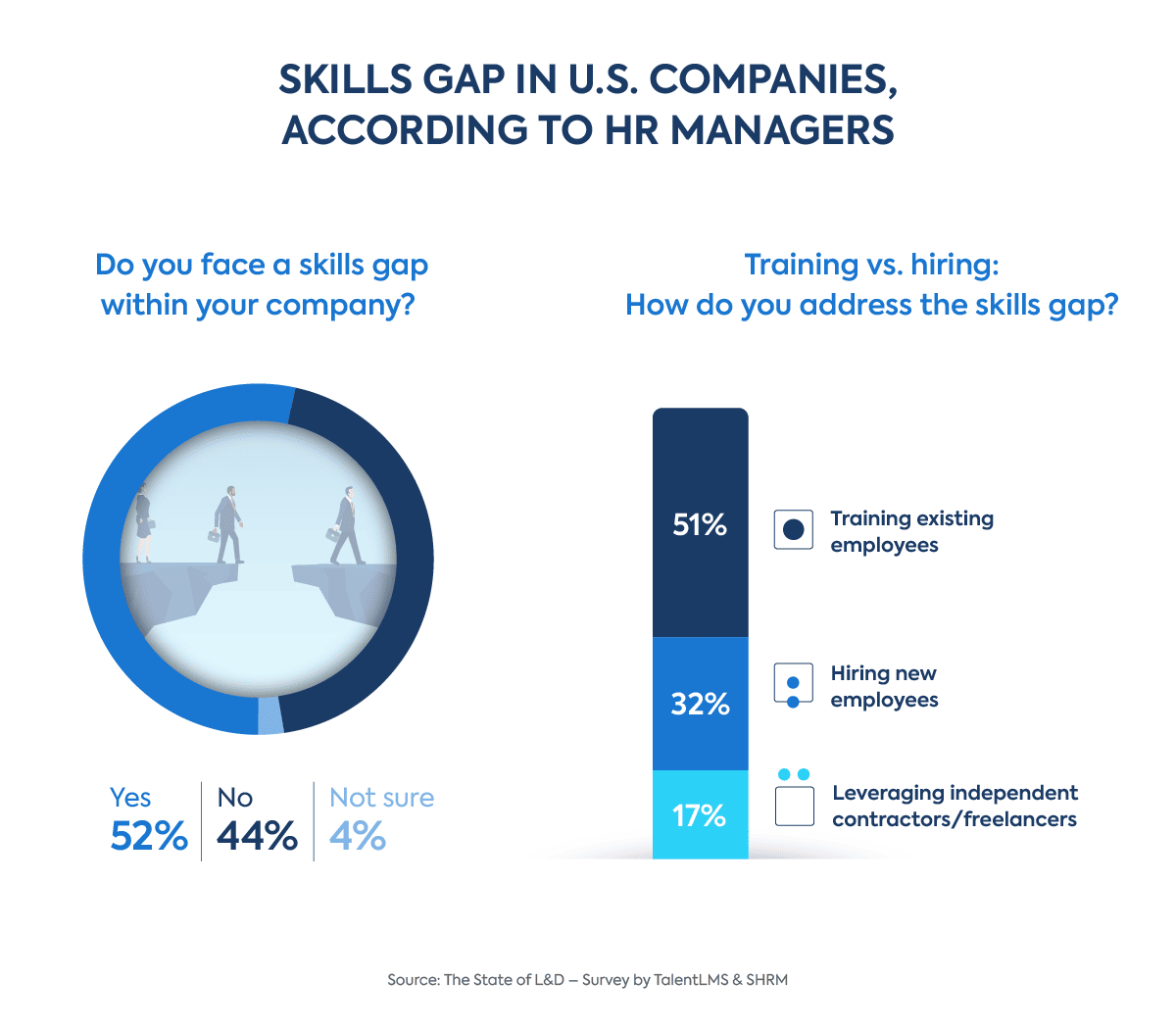
When it comes to bridging the gap, over half of the companies do so by training their existing employees, rather than hiring new ones. Finally, 17% are turning to freelancers and contractors.
Upskilling and reskilling in 2022
Upskilling and reskilling are powerhouse practices for building new competencies among employees and dealing with skills shortage. We asked HR leaders if they plan on investing in them for 2022, and unsurprisingly, the majority said yes.
Specifically, over half of HR leaders will provide their employees with upskilling (59%) and reskilling (55%) training in 2022; while over a third already have both in place.
It’s not surprising that 86% of HR leaders surveyed agree that closing a skills gap is an important training goal. To achieve it, they are creating a variety of initiatives and different types of training. But do those initiatives and targeted skills correspond to what employees want to learn? We’ll examine this next.
Training that resonates: Employees’ expectations are aligned with what employers offer
Overall, employees and employers are in sync when it comes to which training is desired, compared to which training is offered or planned. Here’s what the numbers say:
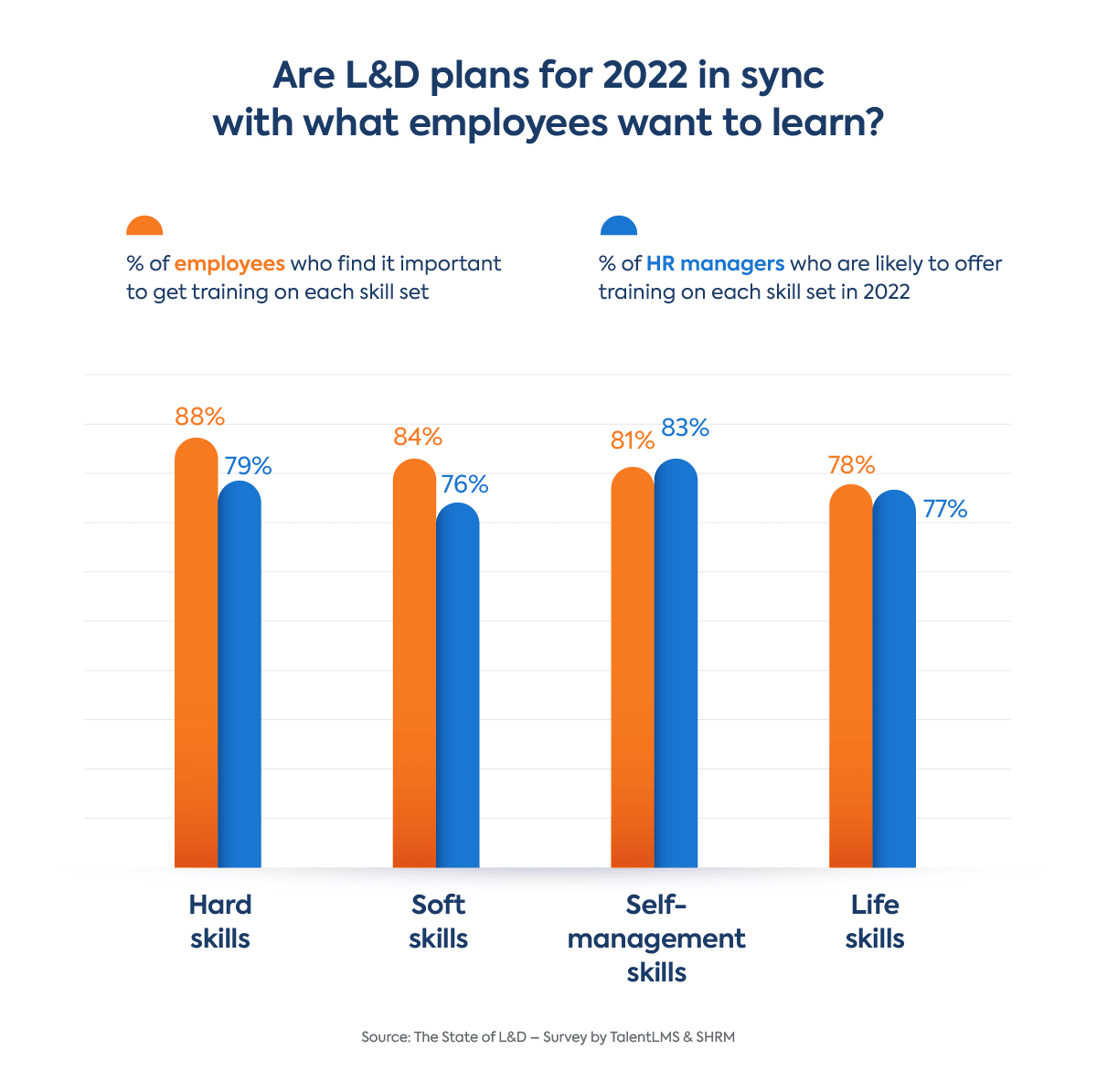
What stands out is that employees prioritize hard skills, while employers seem to focus on self-management skills. In addition, workers won’t be getting as much soft-skills training as they’d like this year. However, the fluctuations are small and the two sides are for the most part aligned on the focus areas of training for 2022.
In-demand soft skills (aka power skills)
Who wouldn’t want better collaboration, teamwork, leadership, adaptability, and creativity in their organization? To achieve these, workplaces need to pay more attention to soft skills and build them among employees.
Experts argue that since soft skills are the skills that give real “power” at work, we should rename them into power skills. They affect every facet of the employee journey and how people work together. For example, when a new hire doesn’t work out, it usually comes down to a lack of soft skills, 89% of recruiters say.
No wonder that soft skills (also called “behavioral skills” and “people skills”) are likely to be the training focus for 76% of organizations in 2022. Additionally, 8 in 10 polled employees find it important to get soft skills training from their company.
We wanted to dig deeper into which specific soft skills employees want to get, and examine if their current training reflects those desires. The graph below paints an interesting picture.
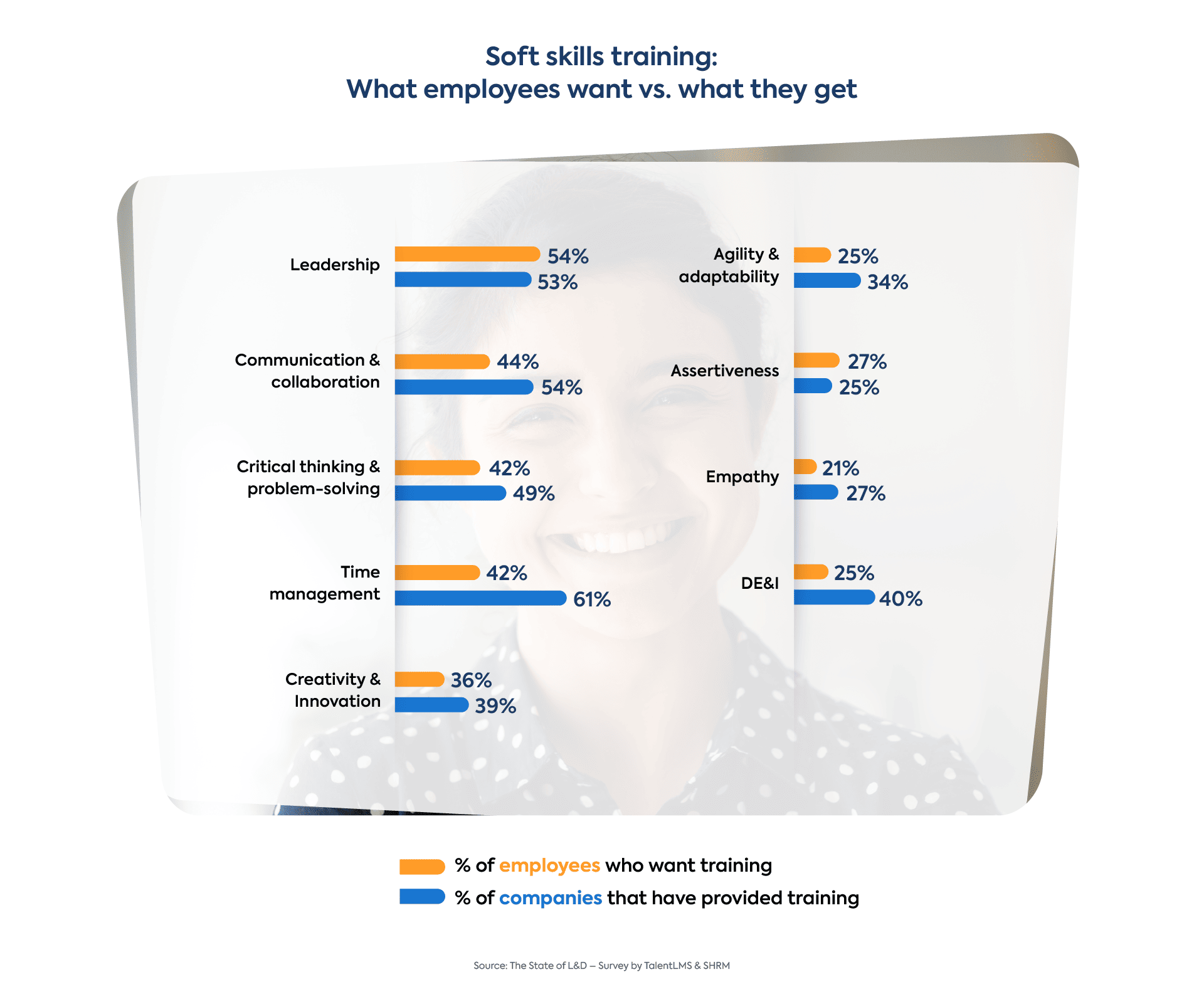
Employees and employers seem aligned on the most important soft skills, and the survey didn’t detect any unfulfilled needs. For both groups, the most in-demand soft skills in 2022 that topped both lists are time management, communication and collaboration, leadership, critical thinking, and problem-solving.
When it comes to prioritizing, it seems that HR managers want employees to be better at time management, while employees don’t seem to share an urgent sentiment in regard to that particular skill. Instead, employees prioritize leadership and collaboration.
What’s more, getting DE&I training is important to 25% of employees, while 40% of companies have provided it.
Humanization of workplace learning: Supporting the mental health and well-being of employees
The pandemic has spurred mental health issues for many people. But it also brought a normalization of mental health challenges at work. As a result, from 2020 onward, mental health support at work went from a nice-to-have to a business imperative. After all, no one can learn or work effectively when stirred up with anxiety, isolation, or burnout.
A recent study by Oracle found that 76% of people believe companies should be doing more to support the mental health of their workforce. With social circles shrinking, work became even a bigger part of people’s lives. It’s much more likely today that employees will turn to their company for support in hard times, than it was in the pre-pandemic world.
The data shows that employers are prioritizing employee well-being: 71% of HR managers agree that if they had a higher budget, they’d invest in mental health and well-being training. Moreover, 77% of HR managers are likely to focus on life skills training this year.
The pandemic has taken a toll on mental health and employers are recognizing the need to address employee well-being through training.
Satisfaction with training and development
When it comes to all workers (employed and non-employed), a recent survey by the American Staffing Association showed their dissatisfaction with corporate training. Only slightly more than one-third said that companies are helping them improve their skills or gain new ones.
However, data from the TalentLMS and SHRM survey of employees who have received training from their current company show a high rate of satisfaction with training: 75% are satisfied with the company-offered training they’ve received. Here’s the breakdown:
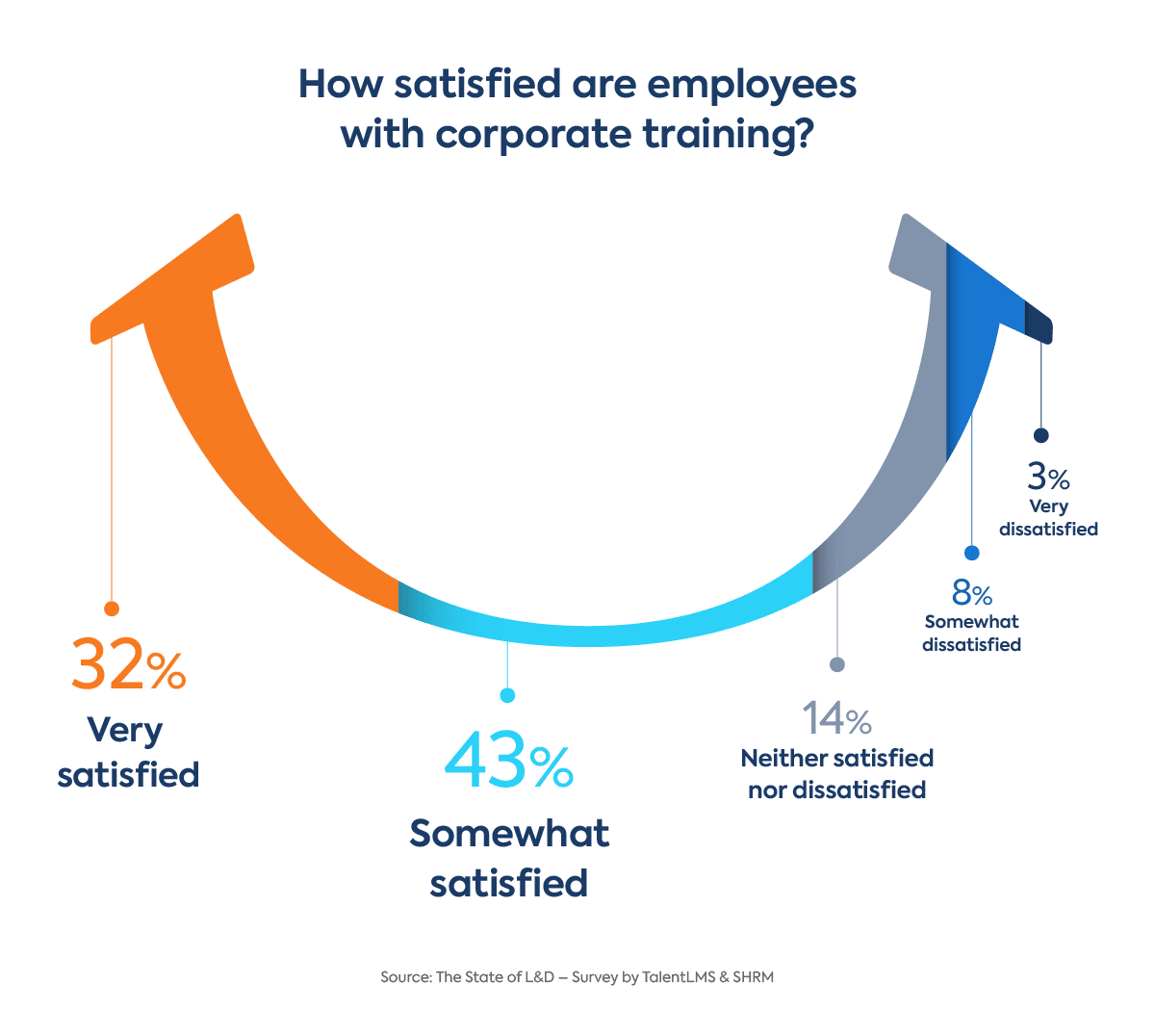
While satisfaction levels are high, the findings from the employee survey shed light on the gaps that still exist in training — for instance, 55% need additional training to perform better in their roles. Here’s what would improve training and make it more spot-on, according to employees.
Improving training efficiency: Better job-training relevance, more social training, and fresh content
We asked employees what would make training more effective. Here are their top picks:
- Align training with job responsibilities (38%)
- Make training more social (32%)
- Update training content more frequently (32%)
People do everything better together — including learning. Almost one-third of surveyed employees say that making training more social would improve the efficacy of workplace training.
But while the majority appear content with learning opportunities, some are still dissatisfied. To find out why, we looked into what employees who are not satisfied with training said would make it more effective.
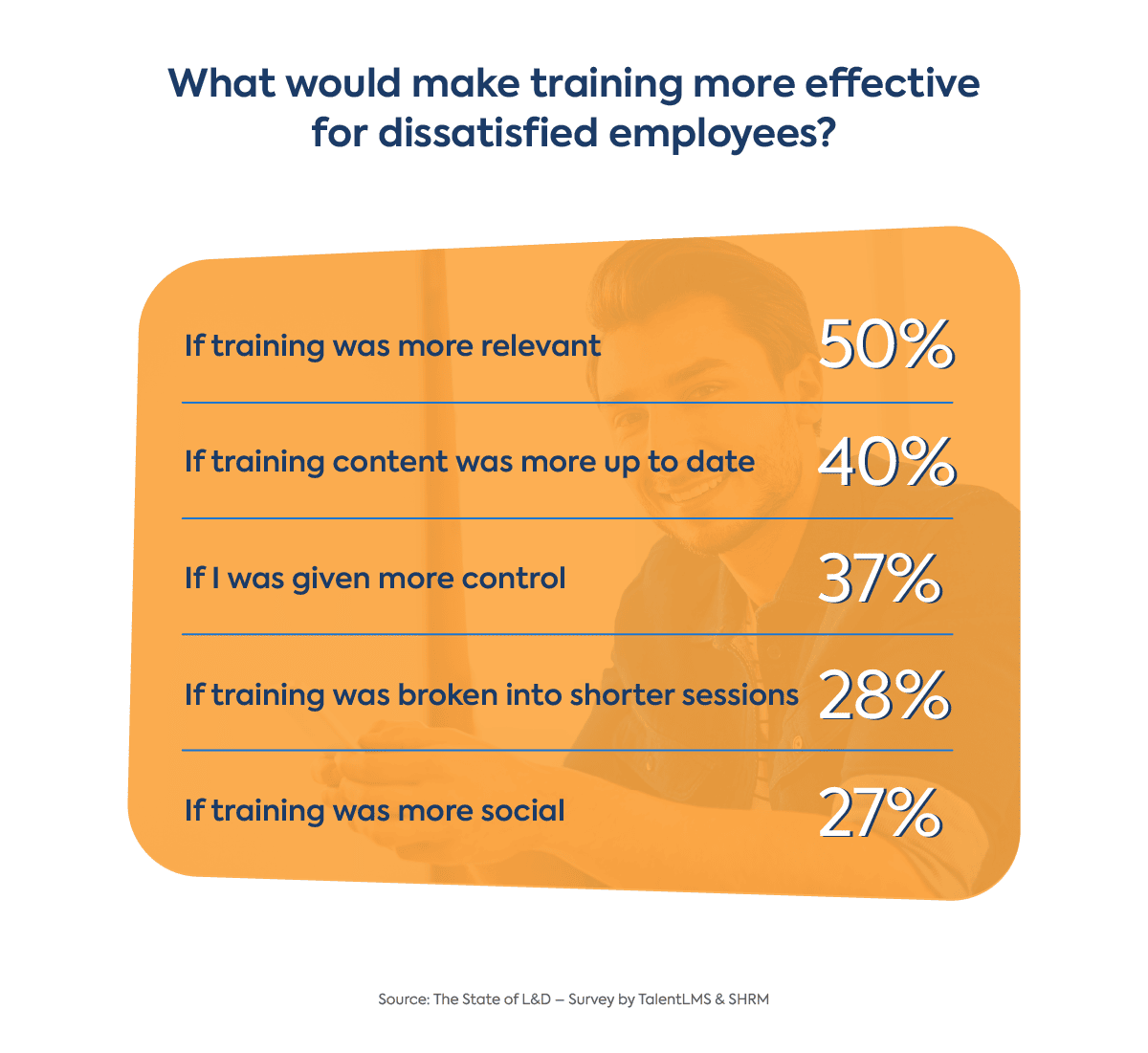
In their own words: Employees share advice on how their companies can make training better
Drawing from their own experience with workplace training, employees share below spot-on tips on how companies can improve learning and development:
«If you give your employees the opportunity to learn and grow personally, those employees will grow your company.«
«Engage your employees. Each individual learns differently and at different speeds.«
«Don’t make training sound like it’s mandatory even if it is.«
«Offer more microlearning because you remember better that way.«
«Give your employees a space to ask for help.«
«Incentivize training opportunities and reward results (when someone practically demonstrates what they learned in training).«
«Help current employees advance even if it’s in a different area of expertise.«
«Offer refresher courses. As many times as an employee might need to be confident to do their job. Recognize if an employee is actually trying.«
«More opportunities on digital platforms.«
«Make it relevant to the current job.»
«Get to know your employee.«
Benefits of training for employers and employees
How training benefits employers: Bottom line, retention, culture, and more
The pandemic accelerated the transition to a more L&D-centric mentality and has brought more visibility and influence to the discipline. However, L&D’s beneficial impact on KPIs was already noted and data shows that training programs are bringing companies a 24% higher profit margin compared to those who don’t invest in training. And the bottom line is just one of the multiple gains.
Here’s what HR leaders said about how training benefits their organization:
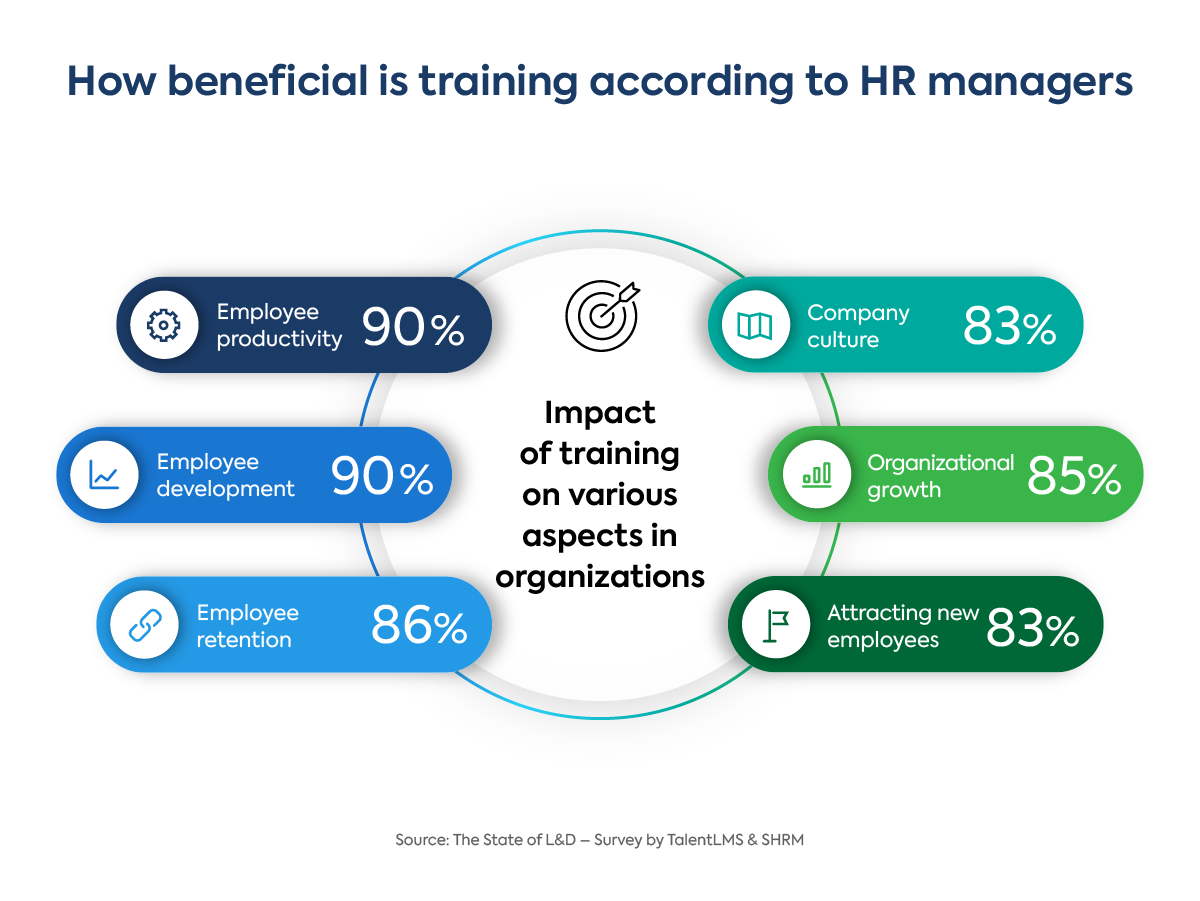
Not only does training have an impact on productivity, growth, and company culture, but it also has a strong correlation with employee retention.
In the age of the Great Resignation, retaining employees seems harder than ever. Yet employees and employers agree that training boosts retention: 76% of employees say that they are more likely to stay with a company that offers continuous training, while 86% of HR managers find training beneficial for the retention of employees.
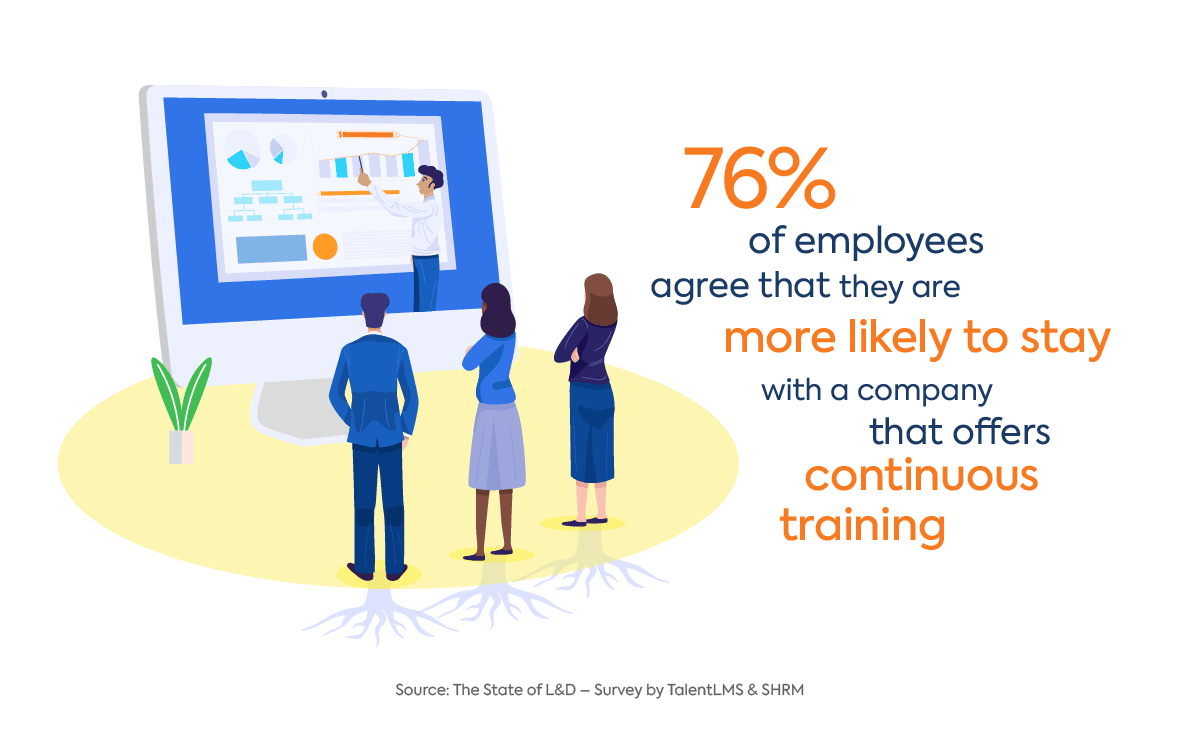
But that’s not all. 8 in 10 leaders find training beneficial when it comes to attracting new employees. In the current climate of talent wars, a comprehensive training and development program can be a talent magnet.
Finally, building a learning culture can enhance organizational resilience, according to 84% of HR managers.
How training benefits employees: Productivity, engagement, job satisfaction, and more
First off, employees find training beneficial for their professional development (82%) and productivity (80%). As mentioned above, 76% say they are more likely to stay with a company that offers continuous training.
Retain your employees by helping them grow
Unlock your team’s full potential with TalentLMS.
The training platform that users consistently rank #1.
Next, 75% find it beneficial for their engagement at work and job satisfaction. Finally, 66% say training is beneficial for their loyalty to the company they work for.
All in all, training is the powerhouse ingredient that can elevate performance, engagement, satisfaction, and employee loyalty.
Training empowers promoting from within
Talking about gains of workplace training, here’s the big one: helping people move up in their careers. When it comes to filling a new role in a company, sometimes the best place to look for a perfect match is not outside, but within. Talent wars have put a spotlight on internal mobility as a solution to the problem of missing skills sets.
But how well are employees prepared for internal transfers?
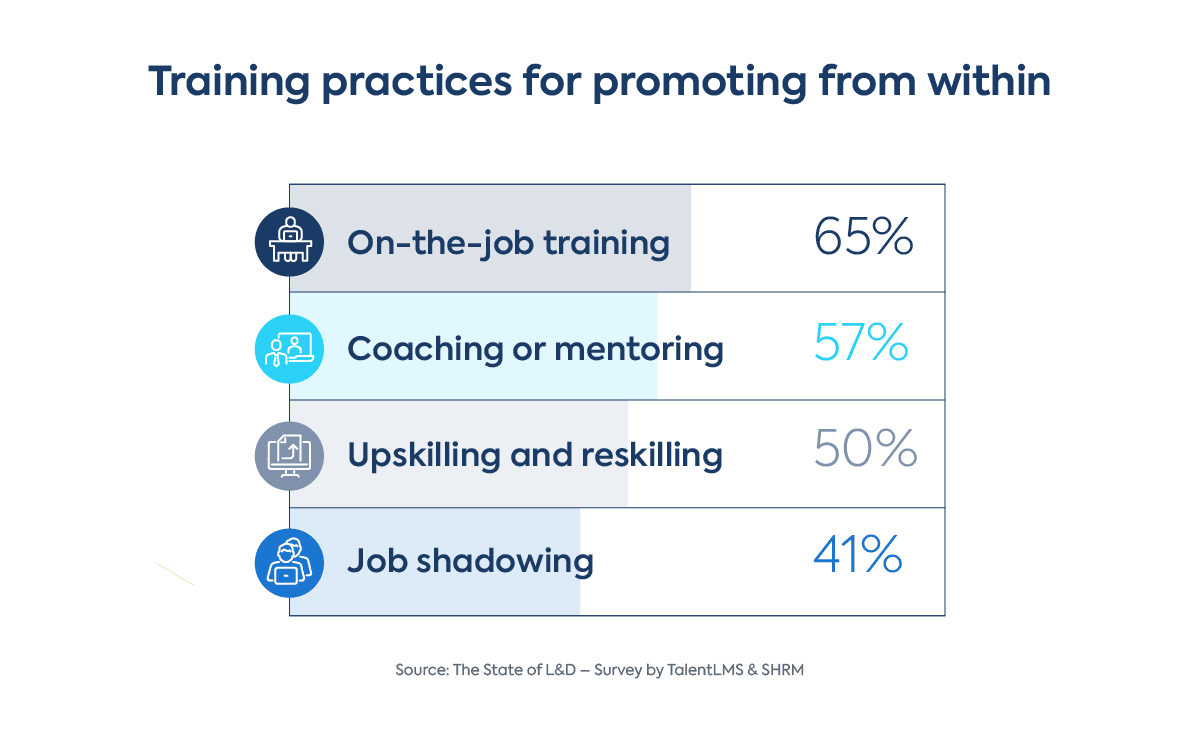
The generation gap in the workplace
In today’s workplaces, four different generations are mingling together: Gen Zers, Millennials, Gen Xers and Baby Boomers. Adding to that mix the various phases of the digital age that shaped each generation differently, and the result is a unique blend of different styles in communication and working.
Meanwhile, the labor shortage is forcing companies to be more creative in their pursuit of workers for filling empty spots. Along with scouting for young talent, a new trend has emerged: re-hiring of retired workers to ease the labor crunch.
This is why we asked if companies have training in place that addresses the generation gap. Here’s what they said:
- 46% have specific training in place for new graduates who are just entering the workforce
- 42% have specific training in place for supporting the re-entry of formerly retired employees
Obstacles in learning and development
When building anything worthwhile, obstacles will come up. Learning is not an exception. So we asked which are the most frequent obstacles when building L&D initiatives in companies.
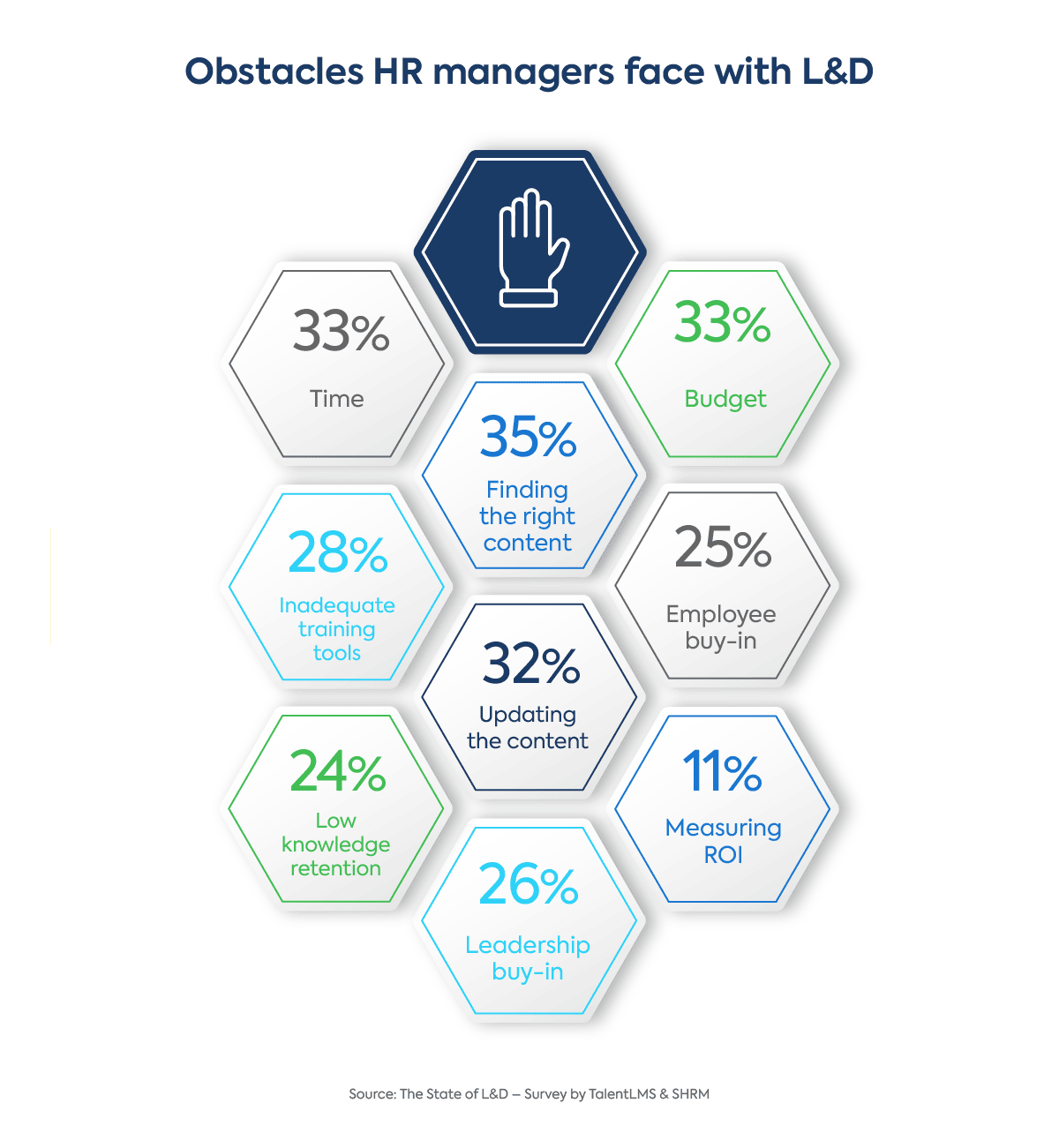
It’s clearer now why 64% of HR managers need additional budget to provide employees with access to online courses — as finding the training content to fit their needs is an obstacle for nearly half of them. Maybe that’s the reason why 78% of organizations prefer utilizing internal learning and training programs.
Interestingly, this echoes employees’ wishes. As we’ll see in the next section, getting access to a library of courses has topped employees’ list of most desired features on a training platform. From the employees’ point of view, the leading roadblock to workplace learning is lack of motivation, with 33% of employees finding it challenging to stay motivated to complete training.
The nitty-gritty of training: Frequency, type, and delivery method
Looking for some handy data on the practical facets of training along with employees’ preferences and employers’ training goals? We’ve got you covered.
Frequency of training
Examining if employees are getting as much training as they need, we found that the favorite training frequency is once every three months. It is followed by a monthly recurrence, as chosen by 1 in 4 employees. Finally, it is worth mentioning that a couple of HR managers said in open-ended responses that they deliver training on a weekly basis.
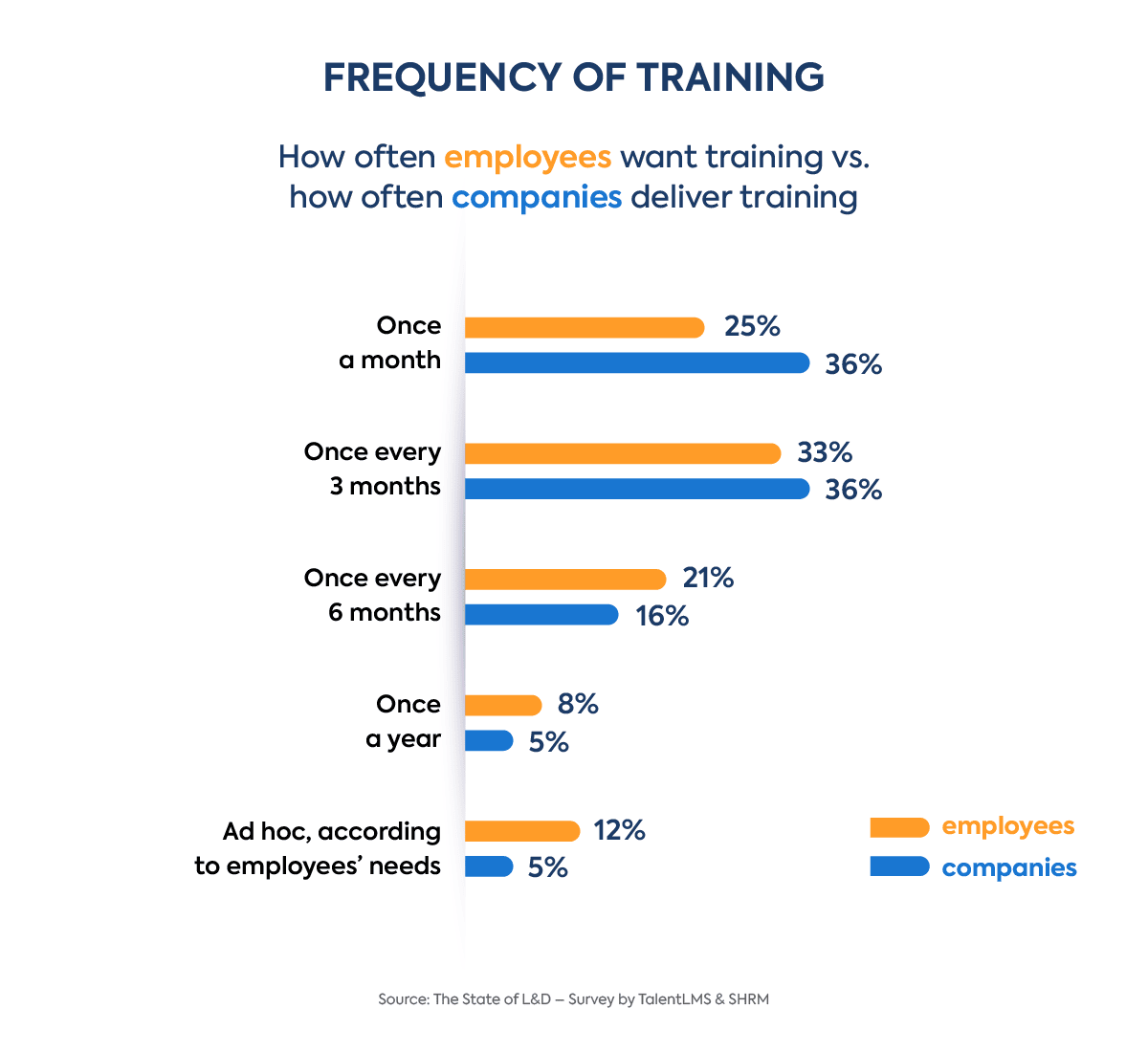
Which kind of training are employees getting from their companies
The employees’ survey showed that the most frequent type of workplace training is compliance. It is followed by soft skills training and upskilling, while onboarding is received by 36% of employees.
Even if it may seem that onboarding is not a top priority, it is not neglected by HR managers as 7 in 10 are providing a three-step approach for increased retention (pre-boarding, orientation, and long-term onboarding).
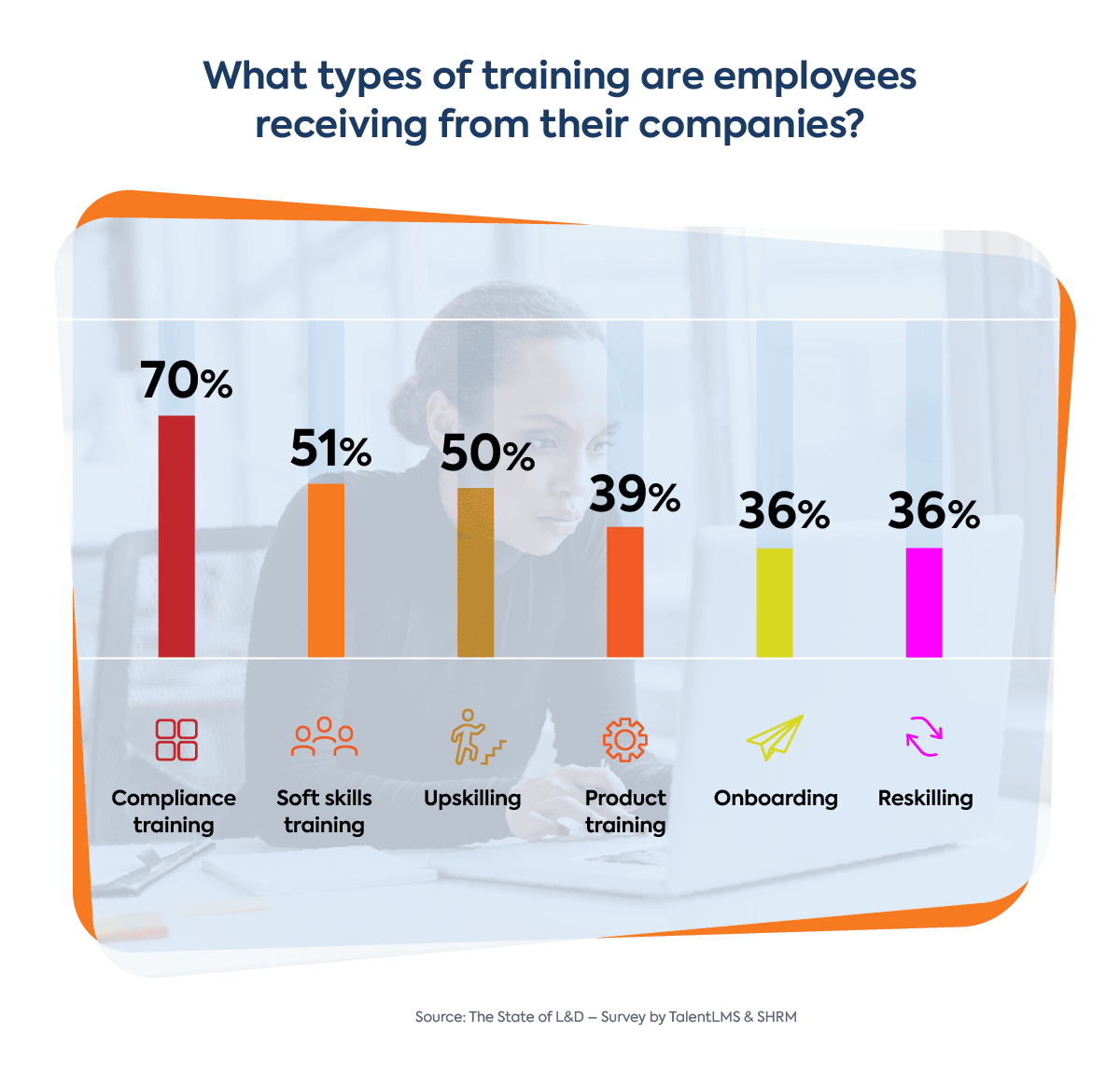
Delivery method and learning formats
When asked which is their preferred training delivery format, the majority of employees picked simulation and learning by doing. This proves that most people learn best through hands-on practice in an environment that resembles their actual job.
Coaching and mentoring is the second-best choice, followed by video format. Microlearning has been picked by 32% who’d like to get their training in bite-sized sessions. Finally, the type of training we don’t see often enough in the workplace is role-playing, which 17% of employees would like to see.
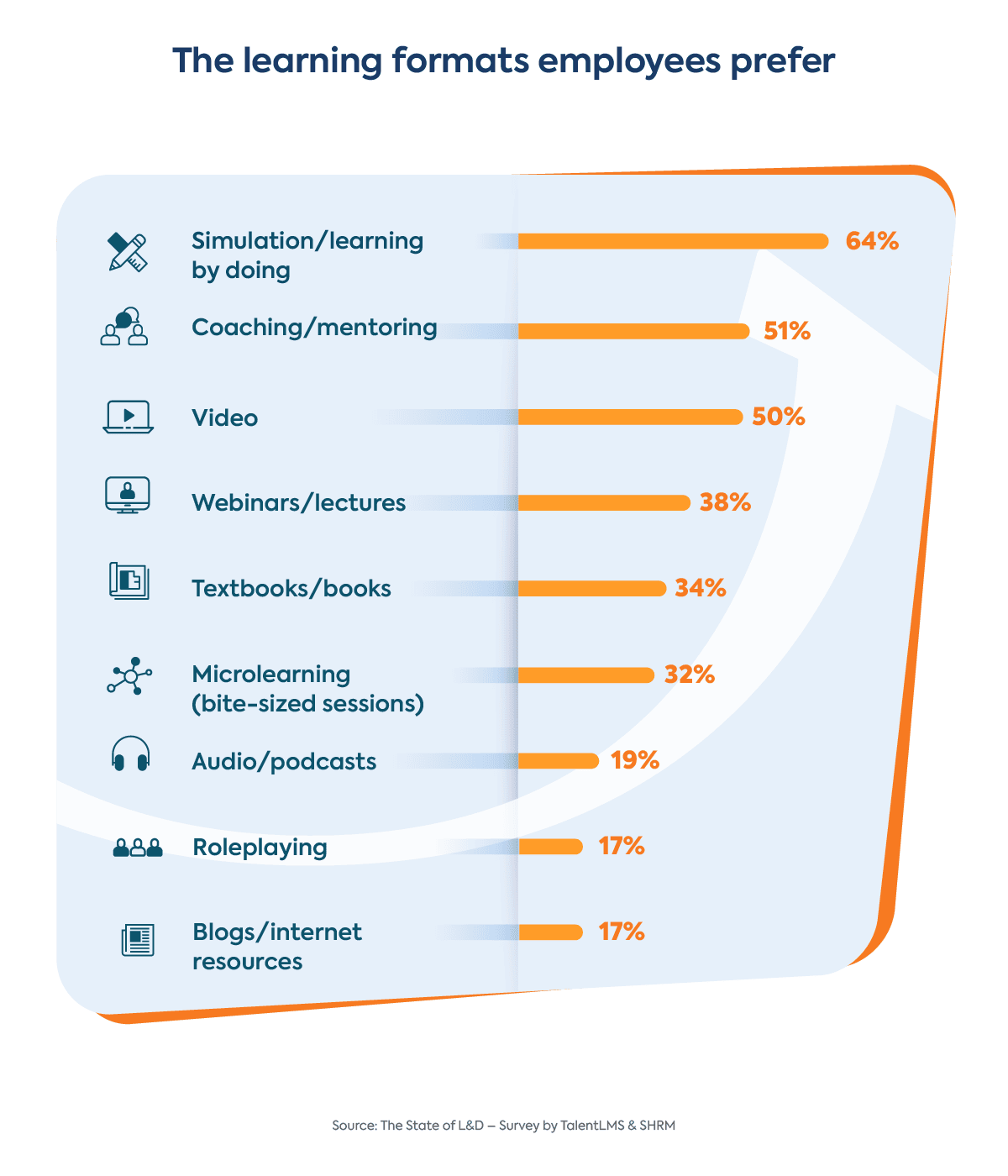
Features that employees would like to see on their learning platform
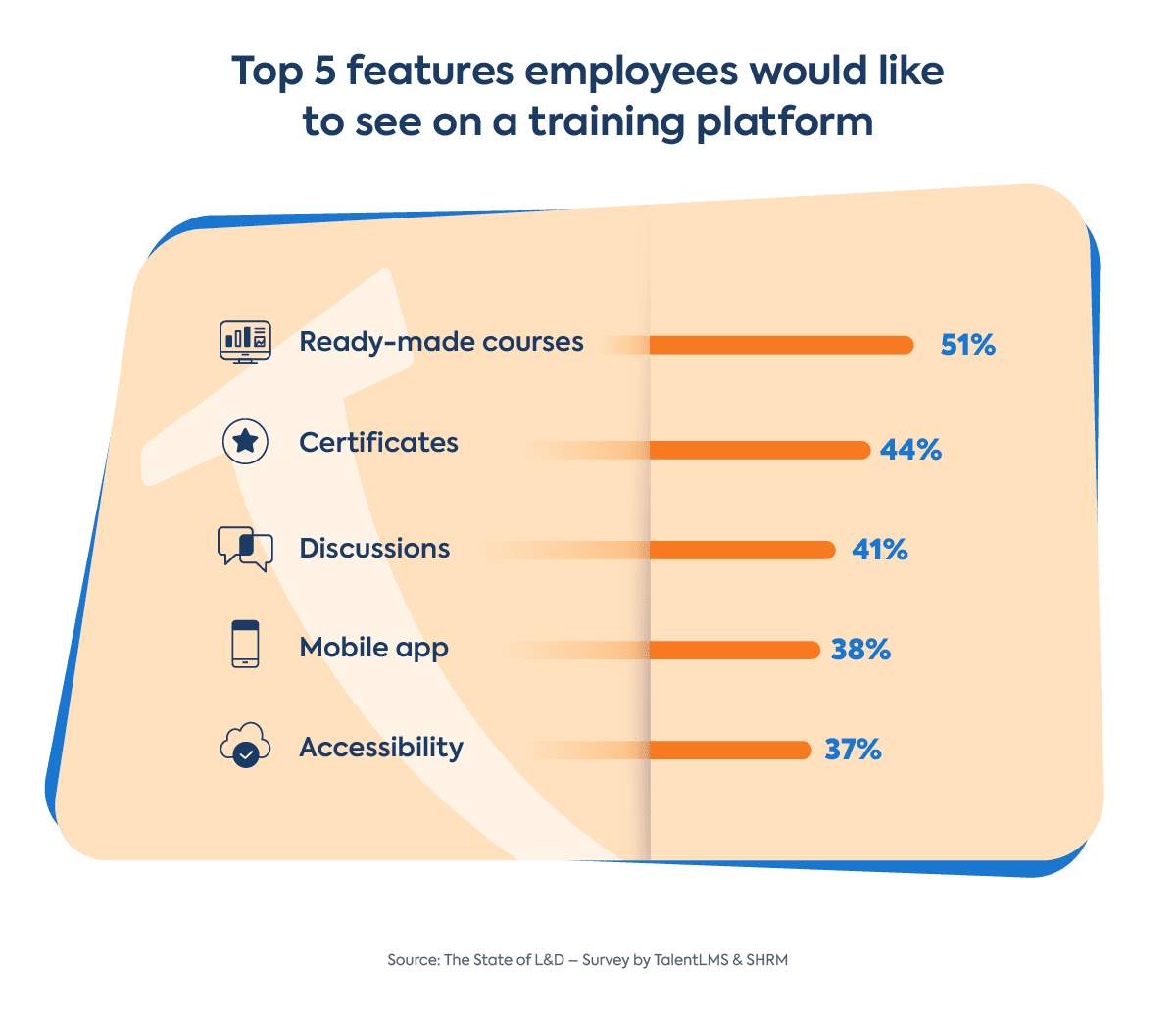
In this research, we sought to uncover the most desirable features on a training platform. And what stood out — as the feature employees would like to see the most in their learning platform — is ready-made courses.
Diving deeper into features, besides certificates, discussions, mobile app, and accessibility — as the graph shows — employees would like to see things like quizzes (37%), chat (33%), gamification (29%), videoconferences (28%), and course rating (25%).
Finally, people mentioned in open-ended responses “learning by doing or some kind of simulations”, which would again translate into a feature, or environment, that enables simulations.
Training goals for organizations
The key to a successful L&D initiative is starting with the end in mind. Of course, L&D practitioners already know that. This is why we asked them which are the most important goals of L&D in their organizations.
What stood out is that the leading goal for the majority is reinforcing positive employee experience. Simply put, employee experience (EX) is the journey an employee takes when joining a company. And training plays a key role in making this journey positive, satisfactory, and fulfilling.
Other important training goals are building a workplace equal for all, creating a growth mindset, and improving employee engagement. We’ll see the rest in the graph below:
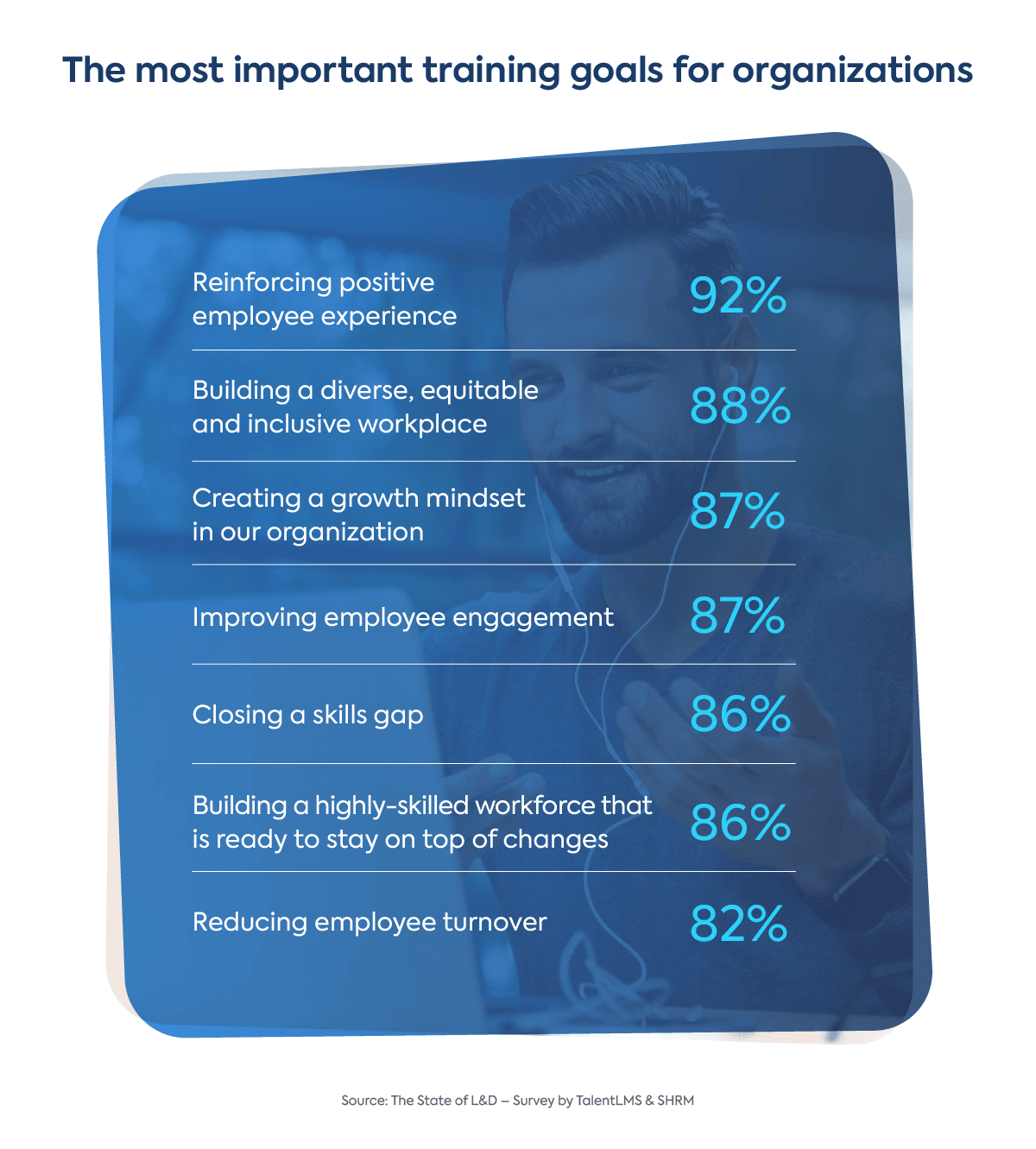
Beyond workplace training
To really understand the current state of L&D, we broadened the focus beyond just employer-provided training. We looked at what types of learning opportunities people are pursuing on a personal basis — and why.
Turns out, people are thirsty for knowledge: 6 in 10 pursue learning opportunities outside of work training. And when it comes to why, the majority (57%) do so because they enjoy learning new things and developing new skills.
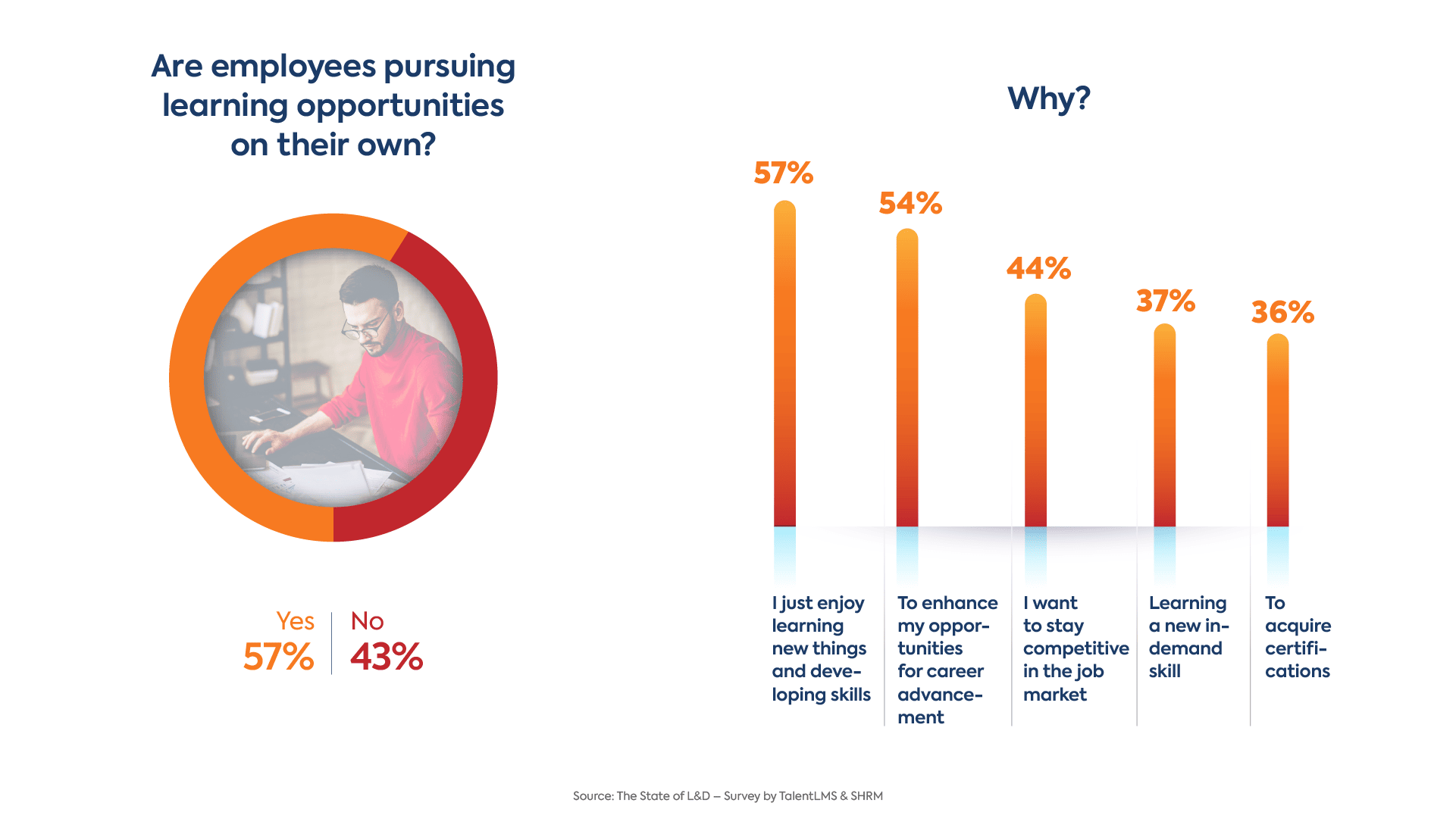
What the future holds for L&D
Throughout this report, we’ve sliced and diced the data to shed light on the current state of L&D. We’ve seen that L&D nowadays plays a key role in influencing employee experience and retaining workplace connectivity and employee engagement. And it is vital for creating a healthy and long-lasting relationship between employee and employer.
79% of polled HR leaders said in this research that there is an emphasis on training and development in their organization. The bottom line is, L&D has become a competitive differentiator.
But what’s coming up next for the industry?
Let’s hear from the surveyed HR leaders themselves. Wrapping up the survey, we asked them in an open-ended question what they expect will change in L&D over the next 5 years. Here’s how they predict the future will unfold by 2027:
Digital-first workplace
“Over the next 5 years, I foresee L&D becoming much more digital. A lot of items today can be presented in person today, and I see that changing soon.”
Humanizing work
“More focus on mental health and burnout prevention.”
“Mental health training will become much bigger as will DE[&]I-related training.”
Nurturing talent from within
“Allowing workers to learn and grow from within with incentives, motivation, and raises or benefits to let them know that they are deserved and respected. To not enforce opinions in the workplace or silence anyone.”
“There will be an increased focus on reskilling and lateral moves.”
Diversified workforce
“There will be a greater emphasis on diversity training.”
Rise of learning tech
“It will move to more immediate feedback and increased focus on ROI with technology based platforms.”
“A greater emphasis of training to retain staff and promote from within. Technology-related training will continue to be extremely important to keep up with changes.”
Employee experience
“Focus more on employee experience, change management, hybrid working, mental health.”
Tightening the skills gap
“Companies will be forced to recognize the skills gap and what they will need to do in order to tighten that gap. I believe more routine training will be implemented for consistency purposes across the entire company.”
Personalizing learning experience
“L&D will need to be more flexible and responsive to individual needs.”
“Let people learn what works best for them.”
About the survey
The report comprises two surveys, which were conducted online between January 29 and February 20, 2022, among two sample groups of U.S. employees. One sample group includes 356 full-time employed respondents whose organizational role is HR manager and who are managing L&D initiatives in their companies, or are involved with them. The other sample group includes 1,001 full-time employees who have received training from their employer in the last 12 months, in addition to onboarding.
ORGANIZATION SIZE OF SURVEYED HR MANAGERS
| 24% | 30% | 26% | 14% | 7% |
| 1-100 employees | 101-500 employees | 501-1,000 employees | 1,001-5,000 employees | >5,000 employees |
ORGANIZATION SIZE OF SURVEYED EMPLOYEES
| 32% | 16% | 13% | 14% | 24% |
| 1-100 employees | 101-500 employees | 501-1,000 employees | 1,001-5,000 employees | >5,000 employees |
Research team
Ana Casic (TalentLMS), Eri Panselina (TalentLMS), Annemarie Schaefer (SHRM), Grace Lee (SHRM).
Train your people. Measure results. Drive growth.
TalentLMS gives you the tools to supercharge every step of your training.





